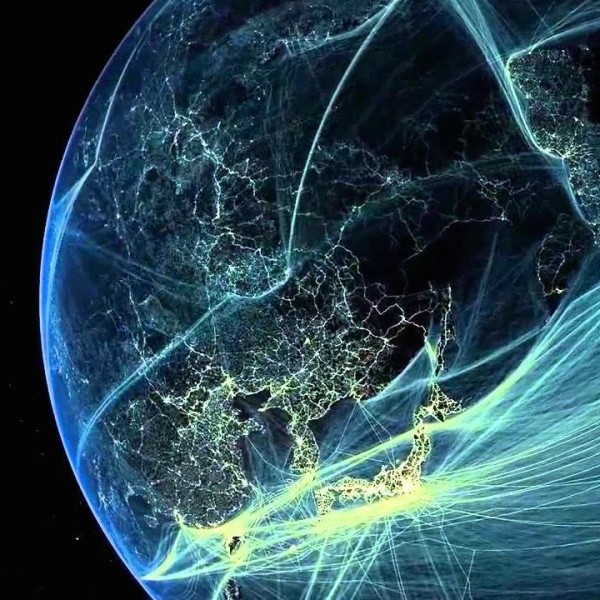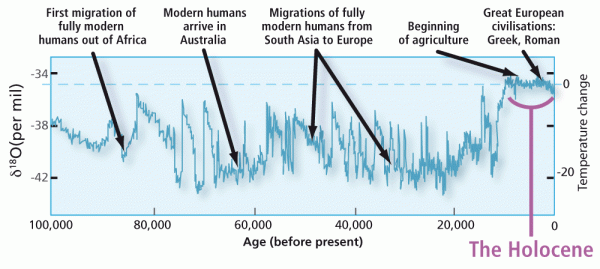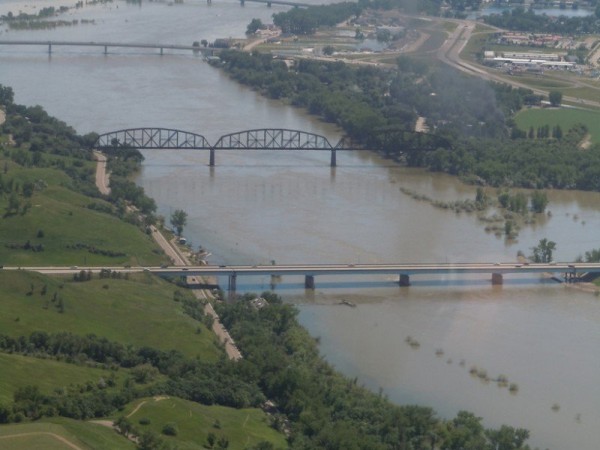
By Lucy E. Edwards via Eos. Article used with permission.
Since Paul Crutzen and Eugene Stoermer introduced the word Anthropocene in 2000, scientists and nonscientists alike have used the word to highlight the concept that we are now living in a time when the global environment, at some level, is shaped by humankind rather than vice versa. Humans have significantly altered Earth’s land surface, oceans, rivers, atmosphere, flora, and fauna. By its emphasis on the here and now and on what humans have done and can do in the future, the word Anthropocene has served as a call to action for environmental sustainability and responsibility [Crutzen and Stoermer, 2000; Waters et al., 2014; Ruddiman et al., 2015].
So far, however, the term Anthropocene has not been integrated into the official Geologic Time Scale, which geologists use to divide the past into named blocks based on the rock record. In 2016 or thereabouts, the International Commission on Stratigraphy—the scientific body that maintains the official Geologic Time Scale—will consider a proposal to formalize a definition of this term.
It’s a decision that has both semantic and scientific implications and may have legal implications as well. Follow the links below to learn more:
![A simplified pollen/spore diagram (redrawn from McAndrews and Turton [2010]) of the record from a lake sediment core with annual layers in southern Ontario, Canada. Variations in percentage of corn pollen (labeled “corn”) and spores from a corn smut fungus serve as a proxy for human impact. Chronology comes from layer counts and radiocarbon dating. (right) Seven of the many concepts of the word “Anthropocene” (A–G) that divide this record. CE = Common Era.](https://earthsky.org/upl/2015/12/anthropocene-illustration-e1451510205570.jpg)
Multiple meanings. Scientists generally agree on certain characteristics of the word Anthropocene:
It is here to stay, with more than 500,000 Google hits and growing.
It carries connotations of human dominance of the environment.
The Anthropocene is not currently a formal part of the Geologic Time Scale.
Underneath our agreements lies a major divergence in philosophy. Let’s start with a simple test. The data shown on the left in the chart above are abundances of corn pollen and corn smut spores in sediment layers in a lake in southern Ontario, Canada (although any proxy for anthropogenic influence could be used).
Can you relate your concept of the Anthropocene to a specific sedimentary record? Your answer likely reflects your views about making the Anthropocene a formal part of the Geologic Time Scale.
If you answered A, B, or C, you probably think you favor including the Anthropocene as a formal part of the Geologic Time Scale—especially if your particular choice of start date is selected. If your choice is not selected, you may not favor formalization at all.
If you answered D or E, you probably oppose formalization. The choice you made is based on cultural considerations—here with either a First Nation (D) or Eurocentric (E) emphasis. You probably don’t want a subset of geologists to co-opt the word Anthropocene for their concepts.
If you answered F or G, you probably mildly (F) or strongly (G) oppose this inclusion.
In any case, no matter how you use the term Anthropocene, others are using the same word with a very different meaning.
Contrasting philosophies. Throughout history, humans have divided time into named portions. Giving a name to something makes communication and analysis easier. For communicating time, two general philosophies are popular among various scientific disciplines.
One philosophy is to name time segments by some means of recognizing defined points in time. For example, the Victorian era can be defined precisely by the dates of the reign of Queen Victoria of England (20 June 1837 to 22 January 1901). Named intervals of time represent the same starting and ending points and are of the same duration everywhere. This precision is relatively easy when dealing with historical time; it becomes more difficult when dealing with the geologic record.
A second philosophy is to name time segments by stages in human cultural development, such as the Bronze Age and the Renaissance. The Bronze Age reflects neither a specific starting date nor a duration of a specific number of years. Rather, it begins and ends at different dates at different places on the basis of the presence or absence of specific features in the development of the civilization present in a particular place.
Geologists, like other scientists, have rules and precedents for formal nomenclature, and these are embodied in the Geologic Time Scale. The scale is tied to the rock record and took shape over centuries, often without strict definitions. Since the 1970s, however, the International Commission on Stratigraphy of the International Union of Geological Sciences has been the arbiter of the terms appearing on the Geologic Time Scale.
The Geologic Time Scale includes only those terms that, to the best of current knowledge, relate to the rock record of specific segments of geologic time. Each unit represents, conceptually, the same interval of time everywhere in the world. Although imprecision in recognizing the time signal in the rock record imposes limitations, no unit of the Geologic Time Scale is specified to have different durations in different parts of the world, and there is no geologic record of the future.
If the Anthropocene is to become a formal part of the Geologic Time Scale, a unique point in time must mark its beginning. Although it is tempting to examine at length the relative merits of various particular starting points, the real discussion should focus on a different question: Can any unique point in time coexist with current Anthropocene concepts and usage? In other words, does the Anthropocene have a beginning that is the same everywhere, or does it begin at different times in different places because it represents a holistic concept that involves time, place, human cultural attainment and dominance, and a variety of environmental effects [Edgeworth et al., 2015; Ruddiman et al., 2015]?

Hierarchy. If the Anthropocene is to be incorporated into the Geologic Time Scale, the International Commission on Stratigraphy will have to deal with the question of rank. Each unit in the time scale has a rank. Eras are divided into periods, which are divided into epochs, which are divided into ages.
A quick search in the scientific and popular literature for the term “Anthropocene” reveals an obvious lack of consensus on its rank. Hundreds of citations refer to an Anthropocene era, an Anthropocene period, an Anthropocene epoch, and an Anthropocene age. In fact, the term “Anthropocene” is so widely employed that many users must be quite unaware of the formal rank terms of geologists.
Rank has consequences. If the rank of era is appropriate for the Anthropocene, the direct corollary is that the Cenozoic era, which began approximately 66 million years ago with the demise of the nonavian dinosaurs, has ended. If the Anthropocene is a period, then the Quaternary period, which began approximately 2.6 million years ago at a time of major glacial-interglacial fluctuation, has ended. If it is an epoch, then the Holocene epoch – the interglacial (warm) interval that began 11,800 years ago – has ended. If it is an age, then it is the current age within the Holocene epoch.
These consequences extend far beyond the scientific community. For instance, many building codes have strict legal definitions of what constitutes a “Holocene fault.” If the Holocene epoch were to be over, perhaps a developer would try to build in an area of active ground movement because, technically, there is no Holocene fault. Or would “Holocene” have two meanings: one geological, one legal?

Possible outcomes. The International Commission on Stratigraphy has set a target date in 2016 for consideration of a proposal to formalize the Anthropocene. I see three possible outcomes:
1. The word Anthropocene will be assigned a specific start time (which will not please everyone) and will be added to the formal Geologic Time Scale. In this case, the word Anthropocene will not have a 1:1 correspondence with any and all things anthropogenic. If the Anthropocene is assigned the rank of epoch, then the Holocene is over. Rigorously applied labels such as Holocene and Anthropocene will be used in all discussions of anthropogenic deposits or anthropogenic environmental effects that originate before the chosen start time.
2. The word Anthropocene will be used in a cultural sense to indicate and call attention to the fact that humankind significantly influences the global environment. It will represent a holistic concept and may have different start times in different places in the world. It may depend on different features or environmental effects. Deposits of anthropogenic origin will be considered Anthropocene deposits. The Anthropocene can easily be depicted on the formal Geologic Time Scale but will not be a formal unit of it. Some people may consider the Anthropocene to be an informal unit of geologic time. Others may not consider it a time unit at all.
3. The word Anthropocene will be assigned a specific start time and placed on the formal Geologic Time Scale, but a significant proportion of its use would be in direct contradiction of the basic tenets of stratigraphic correlation and terminology. Many scientists will now say that it is acceptable to have an Anthropocene epoch that is openly acknowledged to vary in age from place to place. These scientists will include those who in the past have recognized that chronostratigraphic correlation (although never perfect) strives to recognize time equivalence. The term will be used by all but strict-constructionist stratigraphers in a variety of ways to mean different things to different people, most of them thinking that their way is formal and correct.
In the next year or so, the International Commission on Stratigraphy will make a decision, and the rest of us will have to live with it. Is the Anthropocene a specific subdivision in the continuum of time, or is it a holistic concept that includes time but is not defined by it? Which decision will serve us best?

Bottom line: Re-print of an article from Eos in late 2015, by Lucy E. Edwards, discussing the upcoming decision by the International Commission on Stratigraphy on whether the word “Anthropocene” should be formally included in the Geologic Time Scale. Article used with permission.











